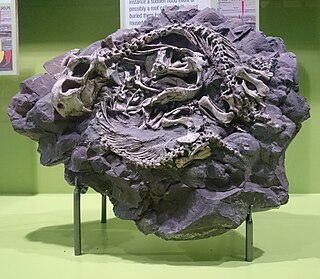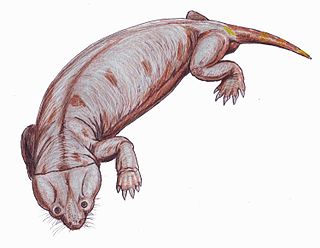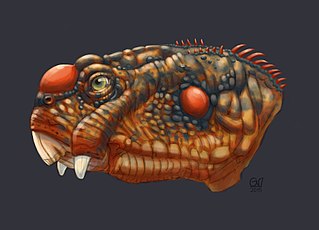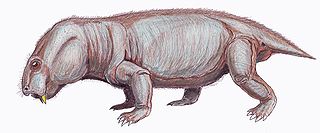This is a list of fossiliferous stratigraphic units in Zambia .
Contents
| Group | Formation | Period | Notes |
|---|---|---|---|
| Ntawere Formation | Anisian | [1] | |
| Beaufort Group | Madumabisa Mudstone | Capitanian-Wuchiapingian | [2] |
| Ecca Group | Luwumbu Coal | Guadalupian | [3] |
This is a list of fossiliferous stratigraphic units in Zambia .
| Group | Formation | Period | Notes |
|---|---|---|---|
| Ntawere Formation | Anisian | [1] | |
| Beaufort Group | Madumabisa Mudstone | Capitanian-Wuchiapingian | [2] |
| Ecca Group | Luwumbu Coal | Guadalupian | [3] |

Diictodon is an extinct genus of pylaecephalid dicynodont. These mammal-like synapsids lived during the Late Permian period, approximately 255 million years ago. Fossils have been found in the Cistecephalus Assemblage Zone of the Madumabisa Mudstone of the Luangwa Basin in Zambia and the Tropidostoma Assemblage Zone of the Teekloof Formation, Tapinocephalus Assemblage Zone of the Abrahamskraal Formation, Dicynodon Assemblage Zone of the Balfour Formation, Cistecephalus Assemblage Zone of the Middleton or Balfour Formation of South Africa and the Guodikeng Formation of China. Roughly half of all Permian vertebrate specimens found in South Africa are those of Diictodon. This small herbivorous animal was one of the most successful synapsids in the Permian period.

The Tapinocephalus Assemblage Zone is a tetrapod assemblage zone or biozone which correlates to the middle Abrahamskraal Formation, Adelaide Subgroup of the Beaufort Group, a fossiliferous and geologically important geological Group of the Karoo Supergroup in South Africa. The thickest outcrops, reaching approximately 2,000 metres (6,600 ft), occur from Merweville and Leeu-Gamka in its southernmost exposures, from Sutherland through to Beaufort West where outcrops start to only be found in the south-east, north of Oudshoorn and Willowmore, reaching up to areas south of Graaff-Reinet. Its northernmost exposures occur around the towns Fraserburg and Victoria West. The Tapinocephalus Assemblage Zone is the second biozone of the Beaufort Group.

The Cistecephalus Assemblage Zone is a tetrapod assemblage zone or biozone found in the Adelaide Subgroup of the Beaufort Group, a majorly fossiliferous and geologically important geological group of the Karoo Supergroup in South Africa. This biozone has outcrops located in the Teekloof Formation north-west of Beaufort West in the Western Cape, in the upper Middleton and lower Balfour Formations respectively from Colesberg of the Northern Cape to east of Graaff-Reinet in the Eastern Cape. The Cistecephalus Assemblage Zone is one of eight biozones found in the Beaufort Group, and is considered to be Late Permian in age.

The Daptocephalus Assemblage Zone is a tetrapod assemblage zone or biozone found in the Adelaide Subgroup of the Beaufort Group, a majorly fossiliferous and geologically important geological Group of the Karoo Supergroup in South Africa. This biozone has outcrops located in the upper Teekloof Formation west of 24°E, the majority of the Balfour Formation east of 24°E, and the Normandien Formation in the north. It has numerous localities which are spread out from Colesberg in the Northern Cape, Graaff-Reniet to Mthatha in the Eastern Cape, and from Bloemfontein to Harrismith in the Free State. The Daptocephalus Assemblage Zone is one of eight biozones found in the Beaufort Group and is considered Late Permian (Lopingian) in age. Its contact with the overlying Lystrosaurus Assemblage Zone marks the Permian-Triassic boundary.

The Tropidostoma Assemblage Zone is a tetrapod assemblage zone or biozone which correlates to the lower Teekloof Formation, Adelaide Subgroup of the Beaufort Group, a fossiliferous and geologically important geological Group of the Karoo Supergroup in South Africa. The thickest outcrops, reaching approximately 240 metres (790 ft), occur from east of Sutherland through to Beaufort West and Victoria West, to areas south of Graaff-Reinet. Its northernmost exposures occur west/north-west of Colesberg. The Tropidostoma Assemblage Zone is the fourth biozone of the Beaufort Group.
Compsodon is an extinct genus of dicynodont belonging to the superfamily Emydopoidea. Fossils have been found in the Balfour Formation of South Africa and the Madumabisa Mudstone of Zambia.

Dicynodontoides is a genus of small to medium-bodied, herbivorous, emydopoid dicynodonts from the Late Permian. The name Dicynodontoides references its “dicynodont-like” appearance due to the caniniform tusks featured by most members of this infraorder. Kingoria, a junior synonym, has been used more widely in the literature than the more obscure Dicynodontoides, which is similar-sounding to another distantly related genus of dicynodont, Dicynodon. Two species are recognized: D. recurvidens from South Africa, and D. nowacki from Tanzania.

Odontocyclops : Greek: ondont “tooth” Greek: kyklops “round eye”, a kind of Greek mythological giant with one eye in the midline =toothy cyclops. The Odontocyclops is an extinct genus of Dicynodonts that lived in the Late Permian. Dicynodonts are believed to be the first major assemblage of terrestrial herbivores. Fossils of Odontocyclops have been found in the Karoo Basin of South Africa and the Luangwa Valley of Zambia. The phylogenetic classification of Odontocyclops has been long under debate, but most current research places them as their own genus of Dicynodonts and being very closely related to Rhachiocephalus and Oudenodon.

The Abrahamskraal Formation is a geological formation and is found in numerous localities in the Northern Cape, Western Cape, and the Eastern Cape of South Africa. It is the lowermost formation of the Adelaide Subgroup of the Beaufort Group, a major geological group that forms part of the greater Karoo Supergroup. It represents the first fully terrestrial geological deposits of the Karoo Basin. Outcrops of the Abrahamskraal Formation are found from the small town Middelpos in its westernmost localities, then around Sutherland, the Moordenaarskaroo north of Laingsburg, Williston, Fraserburg, Leeu-Gamka, Loxton, and Victoria West in the Western Cape and Northern Cape. In the Eastern Cape outcrops are known from Rietbron, north of Klipplaat and Grahamstown, and also southwest of East London.
Syops is an extinct genus of dicynodont therapsid. The type species S. vanhoepeni was first named in 1938 as Dicynodon vanhoepeni. Fossils of the genus have been found in the Cistecephalus Assemblage Zone in the Usili Formation of the Ruhuhu Basin, Tanzania and Madumabisa Mudstone, Zambia. Its phylogenetic placement is somewhat uncertain, with multiple different studies finding it as either a basal geikiid, rhachiocephalid a dicynodontoid more derived than the most basal genera but less derived than Lystrosauridae, or a lystrosaurid.

The Usili Formation is a Late Permian geologic formation in Tanzania. It preserves fossils of many terrestrial vertebrates from the Permian, including temnospondyls, pareiasaurs, therapsids and the archosauromorph Aenigmastropheus.
Kembawacela is an extinct genus of cistecephalid dicynodont from the Late Permian of East Africa. The genus contains two known species, the type species Kembawacela kitchingi from the Madumabisa Mudstone Formation of Zambia described in 2019, and a second species, K. yajuwayeyi, from the Chiweta Beds of Malawi described in 2022. Like other cistecephalids, Kembawacela was specialised for a fossorial, burrowing lifestyle similar to modern day moles. It is unique amongst cistecephalids for the presence of a pair of tusks in the upper jaw, characteristic of many other dicynodonts but lost in other cistecephalids. It is likely that Kembawacela was a locally endemic species of cistecephalid in the Luangwa Basin of Zambia.
The Ntawere Formation is a Middle Triassic (Anisian) geological formation in Zambia, preserving fossils of synapsids, archosaurs, and temnospondyls.